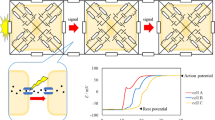Summary
To elucidate the physiological role of phosphodiesterase (PDE) in cardiac pacemaker cells, we studied the electrophysiological effects of amrinone, an inhibitor of PDE type III, on the spontaneous action potential (AP) and membrane currents, using small preparations (0.2 × 0.2 × 0.1mm) of rabbit sinoatrial (SA) node cells. Amrinone (0.1–1.0mM) progressively increased the AP amplitude, maximal rate of depolarization, and spontaneous firing frequency, shortened the AP duration, and made the threshold potential more negative. In voltage-clamp experiments using double microelectrode techniques, 0.1mM amrinone increased the Ca2+ current (I Ca) obtained on step depolarization from −40 to −10mV by 25.86% ± 4.6% (P < 0.05,n = 6), the delayed rectifier K+ current (I K) tail obtained on repolarization from 10 to −60mV by 22.8% ± 4.7% (P < 0.05,n = 6), and the hyperpolarization-activated inward current (I h) at −90mV by 19.5% ± 7.3% (P < 0.05,n = 6), respectively. Amrinone did not affect the slope factors of either the inactivation curve forI Ca (f∞ curve) or the activation curve for the delayed rectifierI K (p∞ curve). These results suggest that this PDE III inhibitor exerts a positive chronotropic action by enhancing the availability and the conductance of all the tested membrane currents in rabbit SA node cells.
Similar content being viewed by others
References
Alousi AA, Farah AE (1978) New cardiotonic agents. A search for digitalis substitute. Life Sci 22:1139–1148
Alousi AA, Farah AE, Lesher GY, Opelka CJ Jr (1979) Cardiotonic activity of amrinone-Win 40680 [5-amino-3, 4,-bipyridin-6(1H)-one]. Circ Res 45(5):666–677
Alousi AA, Farah AE (1980) Amrinone: a new oral and parenteral cardiotonic agent. Trends Pharmacol Sci 1:143–145
Honerjager P, Schafer-Korting M, Reiter M (1981) Involvement of cyclic AMP in the direct inotropic action of amrinone. Naunyn-Schmiedebergs Arch Pharmacol 318:112–120
Millard RW, Dube G, Grupp I, Alousi A, Schwartz A (1980) Direct vasodilator and positive inotropic actions of amrinone. J Mol Cell Cardiol 12:647–652
Jentzer JH, Lejemtel TH, Sonnenblick EH, Kirk ES (1981) Beneficial effect of amrinone on myocardial oxygen consumption during acute left ventricular failure in dogs. Am J Cardiol 48(1):75–83
Tanaka K, Takano T, Seino Y (1986) Effect of intravenous amrinone on heart failure complicated by acute myocardial infarction: comparative study with dopamine and dobutamine. Jpn Circ J 50:652–658
Noma A, Irisawa H (1976) Membrane currents in the rabbit sino-atrial node cells as studied by the double microelectrode method. Pflugers Arch 364:45–66
New W, Trautwein W (1972) Inward membrane currents in mammalian myocardium. Pflugers Arch 334:1–23
Carmeliet E, Vereecke J (1979) Electrophysiologenesis of the action potential and automaticity. In: Berne RM, Sperelakis N, Geiger SR (eds) Handbook of Physiology, the cardiovascular system, vol. 1. American Physiological Society, Bethesda, pp 269–334
Kodama I, Kondo N, Shibata S (1983) Effects amrinone on the transmembrane action potential of rabbit sinus node pacemaker cells. Br J Pharmacol 80:511–517
Simmons MA, Hartzell HC (1988) Role of phosphodiesterase in regulation of calcium current in isolated cardiac myocytes. Mol Pharmacol 13:664–671
Tada M, Katz AM (1982) Phosphorylation of the sarcoplasmic reticulum and sarcolemma. Annu Rev Physiol 44:401–423
Hata T, Noda T, Nishimura M, Watanabe Y (1996) The role of Ca2+ release from the sarcoplasmic reticulum in regulating the sino-atrial node automaticity. Heart Vessels 11:234–241
Taniguchi M, Kokubun S, Noma A, Irisawa H (1981) Spontaneously active cells isolated from the sino-atrial and atrioventricular nodes of the rabbit heart. Jpn J Physiol 31:547–558
Lathrop DA, Nanasi PP, Schwartz A, Varro A (1993) Ionic basis for OPC-8212-induced increase in action potential duration in isolated rabbit, guinea pig and human ventricular myocytes. Eur J Pharmacol 240:127–137
Satoh H, Hashimoto K (1984) Effect of 3,4-dihydro-6-[4-(3,4-dimethoxybenzoyl)-1-piperazinyl]-291H0-quinolinone (OPC-8212) on the membrane currents of rabbit sino-atrial node cells. Arzneim Forsch Drug Res 34:376–380
Hubbard JWH, Conway G, Nordstrom LC, Hartman HB, Lebedinsky Y, O'Malley J, Kosley RW Jr (1989) Cardiac adenylate cyclase activity, positive chronotropic and inotropic effects of forskolin analogs with either low, medium or high binding site affinity. J Pharmacol Exp Ther 256:621–627
Sanguinetti MC, Jurkiewicz NK (1990) Two components of cardiac delayed rectifier K+ current: differential sensitivity to block by class III antiarrhythmic agents. J Gen Physiol 96:195–215
Anumonvo JM, Freeman LC, Kwok WM, Kass RS (1992) Delayed rectification in single isolated from guinea pig sinoatrial node. Am J Physiol 262:H921-H925
Shibasaki T (1987) Conductance and kinetics of delayed rectifier potassium channels in nodal cells of the rabbit heart. J Physiol 387:227–250
Brunkhorst D, Leyen H, Meyer W, Nigbur R, Schmacher CS, Scholz H (1989) Relation of positive inotropic and chronotropic effects of pimobendan, UD-CG212 Cl, milrinone and other phosphodiesterase inhibitors of phosphodiesterase III inhibition in guinea-pig heart. Arch Pharm 339:575–583
Shahid M, Nicholson CD (1990) Comparison of cyclic nucleotide phosphodiesterase isoenzymes in rat and rabbit ventricular myocardium: positive inotropic and phosphodiesterase inhibitory effects of Org 30029, milrinone and rolipram. Arch Pharmacol 342:698–705
Shahid M, Rodger IW (1988) Chronotropic and inotropic actions of amrinone, carbazeran and isobutylmethyl xanthine: role of phosphodiesterase inhibition. Br J Pharmacol 98:291–301
Reeves ML, Leigh BK, England PJ (1987) The identification of a new cyclic nucleotide phosphodiesterase activity in human and guinea-pig cardiac ventricle. Biochem J 241:535–541
Weishaar RE, Kobylarz-Singer D, Klinkefus BA (1989) New mechanisms for positive inotropic agents: focus on the discovery and development of imazodan. Cardiovasc Drugs Ther 3:29–42
Author information
Authors and Affiliations
Rights and permissions
About this article
Cite this article
Hata, T., Nishimura, M., Ogino, K. et al. Electrophysiological effects of amrinone on the automaticity and membrane current system of the rabbit sinoatrial node cells. Heart Vessels 13, 114–121 (1998). https://doi.org/10.1007/BF01747828
Received:
Revised:
Accepted:
Issue Date:
DOI: https://doi.org/10.1007/BF01747828




